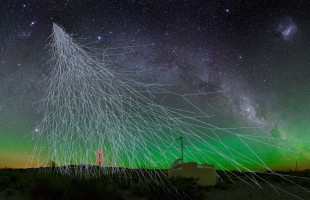4 december 2024
De European Research Council (ERC) heeft zijn 2024 Consolidator Grants toegekend aan 328 onderzoekers in heel Europa. Deze subsidies, met een totale waarde van 678 miljoen euro, zijn bedoeld om uitmuntende wetenschappers en academici te ondersteunen bij het opzetten van hun onafhankelijke onderzoeksteams en het ontwikkelen van hun meest veelbelovende wetenschappelijke ideeën.
Nikhef-onderzoeker Harm Schoorlemmer (kosmische straling/Auger groep) heeft een van de subsidies (3 miljoen euro) ontvangen voor zijn voorstel genaamd ‘Air shower interferometry to advance astroparticle physics’. Schoorlemmer: “Ik ben de ERC erg dankbaar voor de toekenning van de beurs. De kern van het onderzoek is om observaties van deeltjeslawines die veroorzaakt worden door kosmische straling te verbeteren. Dit doen we door het toepassen van interferometrische technieken op de radio-emissie die deze lawines uitstralen. Om een brede impact te maken in de astrodeeltjesfysica gaan we deze techniek toepassen bij het ‘Pierre Auger Observatory’ en het ‘Southern Wide-field Gamma-ray Observatory’. Vol verwachting kijk ik uit wat we gaan leren over de meest energetische deeltjes in het heelal.”
De ERC, in 2007 opgericht door de Europese Unie, is de belangrijkste Europese financieringsorganisatie voor excellent grensverleggend onderzoek. De ERC financiert creatieve onderzoekers van alle nationaliteiten en leeftijden voor projecten in heel Europa. De ERC biedt vier belangrijke subsidieregelingen: Starting Grants, Consolidator Grants, Advanced Grants en Synergy Grants.
Bron: ERC
Het voorstel waar Schoorlemmer zijn beurs voor ontving:
The universe hosts a population of subatomic particles with astonishingly high kinetic energies, so-called cosmic rays. Where and how they obtain this energy is unknown. These particles initiate cascades of particles in the atmosphere called air showers. The particle interactions within air showers are not fully understood and probe a regime not easily accessible by particle accelerator experiments.
I developed a new technique that applies interferometry on the radio emission from air showers. It improves the reconstruction accuracy of air shower properties and hence allows for better determination of the features of cosmic particles. The largest facility for ultra-high-energy cosmic ray detection, the Pierre Auger Observatory, is upgrading its infrastructure to include 1660 radio antennas. This CoG facilitates the interferometric technique for the upgrade by deploying an accurate synchronisation system. The Southern Wide-view Gamma-ray Observatory is a next-generation facility, starting construction in 2026. This CoG augments it with 800 antennas to perform interferometry on air showers.
By improving the air shower reconstruction of these facilities, we aim to extend their capabilities to address major open questions in astroparticle physics. Specifically, the combination of particle detection and interferometry is used to reach these objectives:
– Determine which particles contribute to the cosmic-ray flux at the highest energies, by measuring air shower depth.
– Accurately measure the hadronic interactions in air showers, by simultaneously detailed observations of the muon and electromagnetic components of air showers. The same technique is applied over a wide cosmic-ray energy range.
– Observe astrophysical photons with energies above 1015 eV, to identify the most extreme particle accelerators in our galaxy.
This CoG pioneers the interferometric air shower reconstruction on a large scale and will pave the way for its use in future projects.
